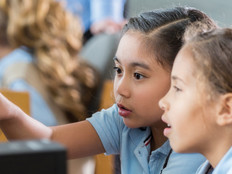Schools Step Up Distance Learning
Distance learning can open up new opportunities for students, especially when it comes to gaining access to some of the more advanced subjects and elective courses.
Two years ago, about 20 college-bound students within the Kansas City Public Schools (KCPS) system wanted to take a physics course. But because these science enthusiasts were spread across the Missouri district's six high schools, no one school had the minimum number of students needed to justify the cost of having a dedicated teacher and classroom. Thus, KCPS didn't offer a single physics class. "Collectively, we had enough students to make a class, but what we needed was a way to bring them all together in one place," says Thomas Brenneman, the district's executive director of technology.
KCPS has since invested in a distance learning system that lets students sit in on live, teacher-led, interactive classes. To make this happen, Brenneman and his IT team transitioned six classrooms (one at each high school) into distance learning laboratories. IT staff outfitted each room with a Cisco Systems TelePresence Codec C40 high-definition video conferencing system, Spectrum Industries instructor centers, AverVision document cameras and Polycom student microphones.
With this setup, a teacher from any school can teach a class, and students from any school can enroll and attend. Brenneman says because these sessions are enhanced by high-definition graphics, "everything is very clear, and students feel like they're in the same classroom as the teacher." Each lab also has an assistant on hand to pass out papers and offer help, he adds.
This past year, 114 students took physics classes, as well as other upper-level courses that were once rarely available at KCPS. In the coming year, students will have even more options, including online courses and dual-credit coursework offered by the University of Missouri–Kansas City. District officials project that they will offer 40 classes to more than 250 students this fall. "We are working to provide our students a variety of options in the way that they learn," Brenneman explains.
"Having more choice in the types and level of courses available to students certainly gives them a leg up on college," he continues, but distance learning also lets students across the district learn from the most gifted teacher of a topic. What's more, the approach gives students a chance to develop virtual relationships with like-minded students who attend other high schools.
"The students help one another and work on problems together, so they really have this sense of friendly 'inter-district' competition because they don't want their school shown up by another school," Brenneman explains. "There's this sense of fun and reward that, I think, helps to make the classes more successful. And the teachers, for the most part, really get excited about their abilities to present information in different ways and to connect with the students a little bit better using technology. We feel it's been very successful so far."
Expanding Options
KCPS isn't alone in making this transition. Kathleen Brantley, director of EdNET Insight for Market Data Retrieval, says K–12 schools nationwide are leveraging advances in networking, video conferencing and web technologies to foster more individualized learning and to give students the flexibility they need to achieve diverse academic needs and goals.
In State of the K–12 Market 2011: Educational Technologies, a survey of 287 district curriculum directors conducted by MDR, 75 percent of respondents said they offered online courses in 2011 — an increase of nearly 60 percent over the 47 percent who were doing so in 2010. And almost 11 percent of the remaining respondents said they had plans to offer online coursework within the next three years. "It's definitely growing," Brantley says. "It will be interesting to see how much and where that occurs."
A number of factors are driving the growth. Some include budget and competitive pressures from independent online and charter high schools for top students. But Brantley says schools also are looking to offer their students more chances to stay on track with their studies and to individualize students' academic experiences. Online learning gives students the ability to take a much wider range of courses and the chance to recover credits and graduate on time.
"Schools no longer require everyone to do the same thing in the same grade level in the same way," Brantley explains. "Some students will accelerate faster and need to be challenged with higher level courses, and others will struggle and need remediation. And later, there are those who need flexibility in their schedules because of athletics or work. Distance and online technologies enable more personalized learning."
1,816,400 The number of students from public K–12 schools who were enrolled in distance or online classes during the 2009–2010 school year
SOURCE: Distance Education Courses for Public Elementary and Secondary School Students: 2009–2010 (U.S. Department of Education's National Center for Education Statistics, November 2011)
The desire for flexibility drives the unexpected growth for the 21st Century Virtual Academy, an online school run by Jefferson County (Jeffco) Public Schools in Golden, Colo. Started just three years ago, the academy has enjoyed great success. In the 2011–2012 school year, 570 K–12 students were enrolled — far more than the 400 participants officials had projected. Director of Student Online Learning Judy Bauernschmidt says she expects as many as 1,000 students to sign up for coursework this fall. Most of the online students are enrolled part time, but one-third of them are full time.
At first, Jeffco Public Schools saw online learning as a way to deal with budget pressures and retain students who were drawn away by for-profit online schools. "It turned out to be something that would address a lot of other areas that the district had been dealing with for years, including 21st century teaching and learning, student achievement issues, graduation rates and dealing with dropouts," Bauernschmidt explains.
Jeffco Public Schools develops its own curriculum and delivers it via a learning management system, but Bauernschmidt says that it's not enough to simply make online courses available. Seeking out and developing top teachers, implementing a marketing strategy to publicize the program, and developing a sustainable funding model all contributed to the academy's success, she adds.
"There's a high-touch element in our schools that makes a huge difference," Bauernschmidt continues, noting that online students also need contact with other students through invitations to school events, field trips and other opportunities. "There are no students who experience what you would call a distance experience, where they're on a computer and that's where they have everything and there's very little teacher feedback or teacher connection. We make sure that our teachers connect with our students every week."
Finally, online curricula need to align with state and district standards. "You have to be able to show that what you're teaching the kids is as good or better than what they have at their own schools, or they won't share their kids with you or refer kids to you," Bauernschmidt says.
Blended Learning
For many schools, online coursework is a supplement to traditional classwork. That's the case for Millis Public Schools in Massachusetts. To give its upper-level high school students a chance to take subjects that aren't available within the district, officials contracted with The VHS Collaborative, a nonprofit based in Maynard, Mass., that offers a variety of online credit-bearing high school courses to students across the country.
"Our resources and elective options are limited, so VHS gives our students an opportunity to take any kind of course they want," says Bob Mullaney, principal of Millis High School. The district pays an annual subscription fee for the service, and Mullaney has released one-fifth of one of his teacher's time (and salary) to teach one VHS course each semester. In exchange for this, 25 of the high school's students can each take one free VHS online course per semester.
Millis High School also offers its students online options through the TEC Online Academy, which was developed by a local school cooperative and involves a per-student fee. It's taught by local teachers but offers a more blended style of learning, as students attend online lessons and also occasionally get together with teachers and classmates for a face-to-face monthly lecture or to work on a hands-on project.
"For some of our kids, this is just a better fit, in terms of the more local touch and what's available," Mullaney explains. He says 26 students participated during the past school year, with many of them taking the co-op's Spanish for Business course as an elective to satisfy requirements for a Spanish immersion diploma.
Because VHS slots and co-op funding are limited, securing a space in the online courses is very competitive. Most students take only one or two courses per semester. There's no required grade point average, but students who want to enroll in a class have to fill out an application, which forces them to reflect on their ability to be self-disciplined, motivated learners, Mullaney says.
Participants still go to campus every day, but during the period reserved for their online course, they report to the library, where they can work on homework. "They can do the online work then or after school, at night or on the weekends, so long as they have access to the materials," Mullaney says.
Although some students struggle with this new learning style, most of them thrive, Mullaney says. "I think it really helps our kids become more independent learners," he says. "It's a great opportunity for them to get this experience in high school, because chances are, they're going to have to take an online class in the future when they get to college or even as part of job training."
Brantley says that these types of online ventures are driving schools to transform from a monolithic teaching style into a more dynamic, student-centric model. "Schools are realizing that they have to do this because it's becoming part of what it means to be a good-performing school," she says. "But it's also good for the kids. They're comfortable with technology, a lot of them really like learning this way, and they do well with it."







